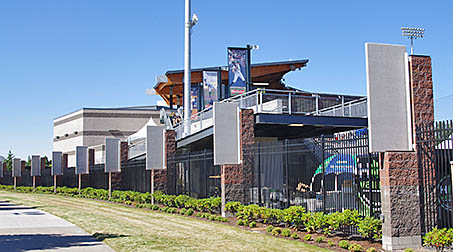Article and all photos by Joe Mock, BaseballParks.com
All rights reserved
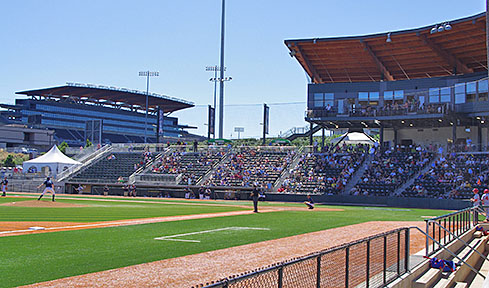 |
If you follow ballpark news around the country, you’ve no doubt heard about various situations where it would make sense for a college baseball program and the local Minor League team to join forces on a new facility.
| Ballpark Stats |
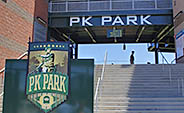 |
| Team: the pro tenant is the Eugene Emeralds of the short-season Class A Northwest League |
| First game: June 18, 2010 — a 6-3 win over Vancouver |
| Capacity: 4,000, of which 2,040 are box seats and another 480 are accommodated on bleachers |
| Architect: DLR Group |
| Construction: Lease Crutcher Lewis |
| Price: $19.2 million for first two phases |
| Home dugout: First base side |
| Field points: Southeast |
| Playing surface: field turf (artificial) |
| Betcha didn’t know: This is the first pro park where there is no dirt in the infield |
And with few exceptions, the deals always fall apart — often with the college getting a new park, and the pro team left on the outside looking in. Columbia, SC had a decrepit downtown park for its longtime South Atlantic League franchise, and with the University of South Carolina’s program on the rise, it seemed natural for the city to build a new facility the two teams could share. Nope. The city threw its support behind the Gamecocks only, so the pro team left town.
In Bakersfield, CA, home of perhaps the worst pro baseball park in the country, Cal State Bakersfield decided to start a baseball program. It made all the sense in the world for the city to construct a shiny new park that both the college and the Cal League Blaze could use. Well, the city has a wonderful downtown arena, but no new ballpark — so the college built a field on campus, and the Blaze continue to toil in woebegone Sam Lynn Ballpark.
Perhaps the most egregious example is the new park that Omaha is sinking $100 million into building for the College World Series. Was the local Minor League team invited to participate in talks to be a tenant at the new showplace? No … and they are a Triple-A team that plays home games over the course of five months, not over the course of ten days a year like the CWS. Not only that, the team was more or less evicted from Rosenblatt Stadium because the city wanted to tear it down so it could expand a zoo. So the Omaha Royals had to search for a new home, finally teaming up with nearby Sarpy County on a new park that will open in 2011.
In Eugene, OR, the University of Oregon decided to revive its baseball program. “How do you resurrect a program after 28 years of non-existence?” asked Richard Higgins, architect and Principal at DLR Group, the designers of the park. “Set a deadline, hire a top-flight coach and build the best baseball facility in the PAC 10.”
So the athletic department started planning to build a showplace ballpark on campus. The longtime Northwest League team in town seemingly could use a new park, because its home, Civic Stadium on the other side of downtown from campus, was a 70-year-old, deteriorating structure.
Perfect match, right? Well, in this case, there was significant opposition to the Emeralds moving away from Civic Stadium, both from their fan base and the local press.
As if starting a Division I college baseball program from scratch wasn’t challenging enough, getting the Ems on board made the job of paying for a first-rate new ballpark even harder. Make no mistake about it: the Ducks could’ve pulled this off without the participation from a pro team. However, the ownership of the Emeralds saw the longterm benefits of playing in a first-class stadium, especially as it related to its affiliation with a Major League parent, who always want their farmhands playing in newer facilities. So the Elmore Sports Group declared their allegiance to the project, despite the opposition from many of their more vocal season-ticket holders and the editorial writers of the local paper.
| Left to rot |
 |
| Civic Stadium originally opened in 1938 as part of a Depression-era WPA project. I heard the word “beloved” applied often to the facility, but the fact that Ems fans felt this way had to be based on sentimentality instead of logic, because the cavernous, decaying structure was anything but nice. The photo above shows how it looks today. The local school board owns the facility, and they should demolish it soon before kids break in and get injured. |
The athletic department, led in this endeavor by Senior Associate Athletic Director Joe Giansante, very intelligently decided to approach the ballpark in three “phases.” The first stage was to construct the field itself so the brand-new Ducks baseball program would have some place to play in its inaugural 2009 season. Phase Two would involve the construction of most of the structure surrounding the field, and would make it a place where the Ems could play in 2010. Phase Three (which isn’t yet fully planned, nor has a budget been set for it) would expand the ballpark and add any facilities deemed necessary after it had been used by a season by both the Ducks and Ems.
Anyway, in early 2008, the University put the project out to bid, and the landscape architects who were picked to prepare the site and the field itself was CMGS of Eugene. Lease Crutcher Lewis was selected to construct the park, and DLR Group won the bid to be the architects.
The three companies selected to make PK Park a reality were all excellent choices. In particular, DLR had an impressive portfolio that included our Ballpark Of The Year in 2006, Fluor Field (called West End Field when it opened) in Greenville, SC, and the very impressive $27 million renovation of Disch-Falk Field on the campus of the University of Texas. In addition, DLR has a productive and creative office in Portland (plus a wealth of ballpark expertise in their Omaha location), so the designers could meet regularly with University officials in Eugene.
Getting PK Park to its 2010 configuration cost a total of $19.2 million, and in modern-day construction dollars, I think the sum was extremely well spent. The vast majority of the money, of course, came from the University and its boosters — one of whom, Patrick J. Kilkenny, contributed enough so that his initials became the name of the ballpark.
So the Ducks and the Emeralds pulled off a Minor League/college joint venture where many others had tried and failed. Did it result in a good park, though? Let’s now follow our normal format for these reviews, where we look at PK Park’s location, exterior, interior design and fan amenities.
The Setting
Since the University was writing the checks for this new ballpark, there was never any controversy over whether the park would be on their campus or not. Of course it would be. But where?
The natural choice was to put it near Autzen Stadium, the University’s massive football facility. That way it could take advantage of the existing parking and, it turns out, use the same ticket office for football and baseball games. However, when the ideal spot was determined (just to the east of the structure of the football stadium), it turned out that it was going to wipe out some very, very premium parking spots for football games, right next to the ticket windows and one of the main entrances.
I’m sure some longtime boosters grumbled at having their favorite spaces eliminated, but this really was the best spot for the new baseball facility. For one thing, it places PK Park right along the beautiful (and heavily traveled) tree-lined Martin Luther King Blvd., which runs along the northern perimeter of Autzen Stadium. This is a significantly nicer spot than somewhere in the middle of the football parking lots.
So from the University’s perspective, the site is ideal because of the plentiful parking (well, for baseball games anyway, since a number of spaces that had been prime football spots are now gone) and its proximity to the rest of the athletic venues (with all of their training and conditioning facilities). One aspect of the ballpark’s location that shouldn’t be undervalued, though, is its usefulness on Saturdays in the fall. The luxury suites on PK Park’s upper level will be in high demand for pre-game tailgate parties — minus the tailgates, I guess — plus lots of pigskin fans will be exposed to the beauty of the ballpark’s interior when they come to party before Duck football games. They can then “duck” right into the stadium before kickoff, using a ramp that is just outside the first-base side of the ballpark. The photo at the top of this page shows the proximity of the two structures.
Does the location work as well for pro baseball? Maybe not, because it’s nice when a ballpark has a neighborhood setting, which PK Park definitely does not have. However, it’s a pretty spot, with lots of mature trees and, I have to admit it, the mammoth football stadium right next door does provide visual interest (a little later, we’ll address how the two facilities are compatible architecturally). Also, the park has great visibility along heavily traveled MLK Blvd., plus the intersection of north-south Interstate 5 and east-west I-105 is just a few hundred yards away through the woods.
However, don’t think that it’s a snap finding the ballpark from that interchange. I knew approximately where it was, and I was looking quite intently for it through the trees — but you simply can’t see it. That makes it a little difficult to get your bearings if you haven’t been there before. In fact, from that interchange, you have to travel almost two miles due west on I-105 before exiting to head back east to the ballpark. And once you exit, you will be on three different streets (Coburg Road, Southwood Lane and Country Club Road — which is also called “Club Road”) before you finally wind around and connect with MLK Blvd. It is confusing, to say the least. Try your best to look for signs directing you to Autzen Stadium, because once you find the football stadium, PK Park is right next door.
By the way, if you want to park really close to the ticket windows and main entryway, you can pay $3 (same price as in the football lots, which are on the far end of the ball field) and park directly across MLK Blvd. at the Masonic Lodge.
  |
The left-hand shot above shows the new and the old, with the baseball stadium’s “tower” in the foreground and the top of the south stands of the football stadium beyond. In this shot, tree-lined MLK Blvd. is just to the right. The right-hand photo points toward the main entry, with MLK Blvd. to the left. The football stadium’s main ticket windows (also used for baseball, remember) are just to the right.
The Exterior
It’s now time to examine one of the pro-baseball/college partnerships that was successful, because it offered a good template for Eugene to follow. On the campus of Penn State in State College, PA, you’ll find Beaver Stadium, the 107,000-seat home of the Nittany Lion football program. In the mammoth stadium’s shadow is Medlar Field at Lubrano Park, which was completed in 2006 for PSU’s baseball team. The park features an outstanding view of Mount Nittany beyond center field. Penn State’s basketball arena, the Jordan Center, is a short walk across the parking lots.
For two-and-a-half months each summer, the NY-Penn League plays at Medlar Field, as it is the home of the State College Spikes. Our 2006 review of the park was based on attending a Spikes game in July that year.
Both the NY-Penn League and the Emeralds’ Northwest League are short-season circuits, and their seasons start after the college season has concluded. Not only do the Nittany Lions and the Spikes co-exist beautifully, the architectural compatibility of the football, basketball and baseball facilities is also a thing of beauty. Everything from the park’s brick to its landscaping is meant to resemble what you see at Penn State’s nearby facilities.
PK Park in Eugene follows the same avenue, with an exterior that looks gorgeous next door to Autzen Stadium. The color scheme and landscaping look perfect next to the football facility … and, in fact, the large wooden structure that you see in the right-hand photo in the Setting section above came from within the football stadium. It was a support for the wooden roof that was no longer necessary when renovations were done to the south stands. I’m guessing that you won’t be surprised to learn that the DLR Group was one of the architecture firms that worked on the design of Medlar Field, because their ability to create such compatibility between different facilities was also utilized well in Eugene.
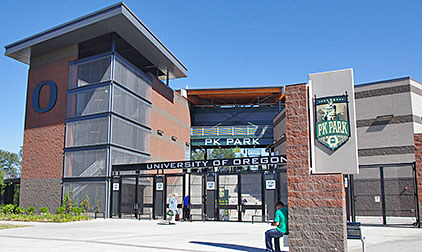 |
A closer look at the main entryway for PK Park (above) shows the wonderful use of contrasting brick and light-colored block, as well as the “tower” to the left of the gates. The tower essentially surrounds stairs and isn’t an essential aspect of the facility from a structural point of view, but aesthetically, it serves a wonderful purpose to break up the elevation of the park’s roof. We’re seeing this more and more in new minor league parks (including in Tulsa and North Little Rock), and this is a good thing, because it seemed like every new park for about 15 years had a perfectly flat upper-level roof, making it difficult to distinguish one park from another. The tower here — which one day will have ivy growing up the mesh walls, if the ivy plants cooperate — serves the important purpose of differentiating the exterior of PK Park from other recent-vintage Minor League stadiums.
The architects had something else in mind, too. “We asked ourselves the question ‘How do we make it (PK Park) present itself so it isn’t overwhelmed by Autzen Stadium?'” said DLR’s Project Manager Robert Esau. One way was to devote attention to other elements of the exterior.
|
|
For instance, on the first-base side, they erected a series of concrete blades or panels, complete with masonry supports and lights to illuminate them. While they look attractive now, one day they will be even better, because they will be adorned with UO players and events that will be memorialized as part of a “Baseball History Walk.” A little presumptuous of a program that was dormant for 28 years? Sure, but they are ready for big moments and star players.
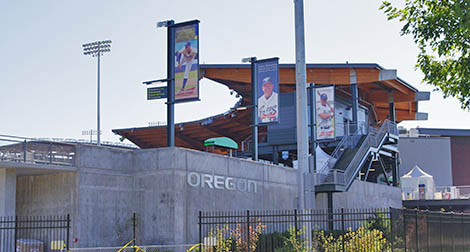 |
PK Park’s exterior that you see on the third-base side is shown above. Take a look at the horizontal supports that hold up the roof. Do they look familiar? They are patterned after the supports that used to hold up Autzen’s roof … and that now are inserted vertically in the ground around the athletic complex, such as the one in front of PK’s gates. This is something that is very visible from the outside of the park, and is a great feature …. as is the roof itself, which we’ll examine in our next section.
